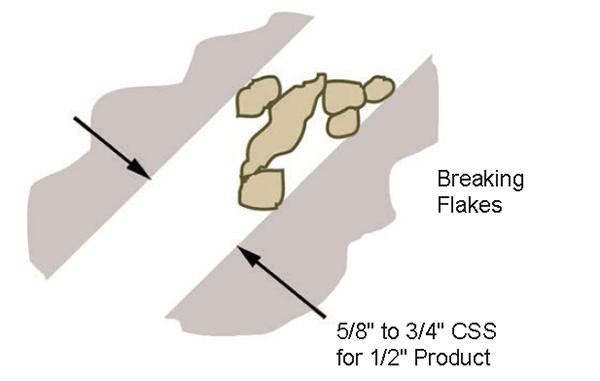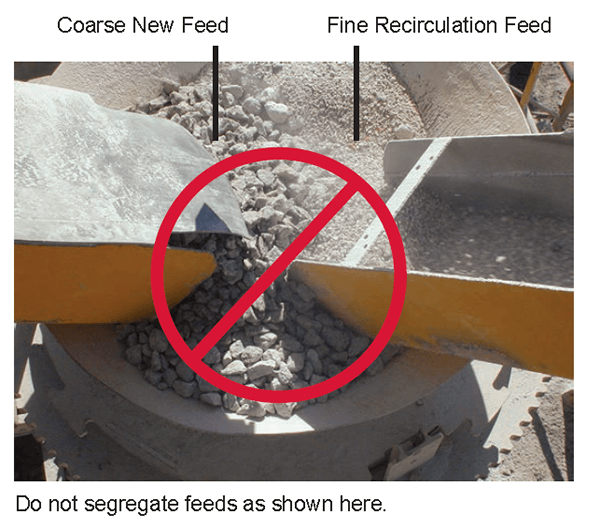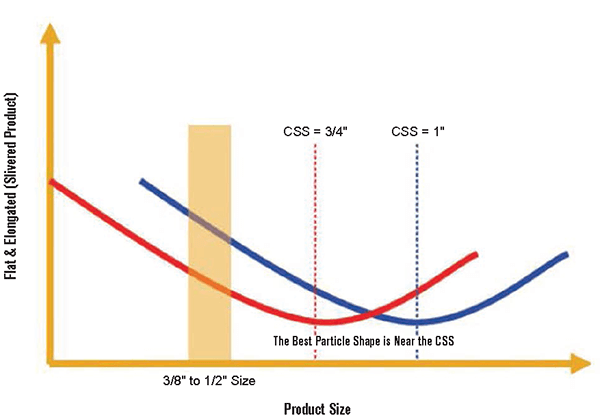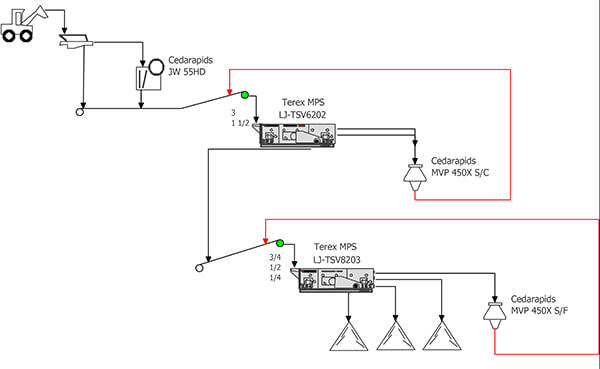Eleven Rules for Better Product Cubicity
When making a specification product with a small allowable F&L, the following process controls when correctly applied to the crushing circuit will minimize the flat and elongated particles generated inside the cone crusher:

Figure 1 Mixture of Small and Large Feed Material Promotes Attrition Crushing
Please note that while it is beneficial to retain up to 10% of feed below the CSS, it is very important to screen sand out of the feed (#4 minus) to minimize compaction and avoid bowl float. Bowl float must not be allowed.

Figure 2 Segregation of Feed Material
As Figure 3 indicates, there are fewer F&L particles in the 3/8" x 1/2" product size when the CSS is 3/4" than when the CSS is 1". Therefore, the best product shape will be in those products that are close to the crusher CSS.

Figure 3 Particle Shape in Relation to Closed Side Setting

Figure 4 Closed Circuit
1. Keep the Crusher Choke Fed
Choke feed means to keep the head covered with approximately 6" of feed material. Conditions that help keep the crusher choked include surge bins, adjustable speed feeders, and automation that regulates the feed rate of material into the cone. Bowl float must not be allowed.2. Stable and Continuous Feed
The gradation of the feed material must be continuous from the maximum to minimum particle size. Do not allow “holes” in the feed gradation (gap graded material). Use a well graded feed (90% - 100% passing the CSS, 50% - 80% passing the chamber mid-point, 0-10% passing the crusher CSS).3. Keep Some Material Smaller than CSS in Feed
Keep up to 10% of feed below the CSS to encourage rock-on-rock attrition crushing. The small particles in the feed fill the voids between the larger particles which increase the density and promote attrition crushing thereby improving the product shape. It sometimes helps to set the CSS somewhat larger than the screen size to keep the small material in the feed. For example if you use 1/2" screen wire to make a 1/2" product, setting the crusher CSS at 5/8" to 3/4" will retain the 1/2" by 5/8" in the crusher feed to promote attrition crushing as illustrated in Figure 1.
Figure 1 Mixture of Small and Large Feed Material Promotes Attrition Crushing
Please note that while it is beneficial to retain up to 10% of feed below the CSS, it is very important to screen sand out of the feed (#4 minus) to minimize compaction and avoid bowl float. Bowl float must not be allowed.
4. Restrict Final Stage Reduction Ratio to 3:1
Maximum feed size should be restricted to 2" so the voids between feed particles can fill with fines and promote attrition crushing to break the flaky elongated particles.5. Distribute the Feed Evenly
Crusher feed should be at the center of the feed opening. Avoid feed segregation where the coarse new feed is on one side of the feed opening, and the fine recirculated feed is on the opposite side of the feed opening as shown in Figure 2.
Figure 2 Segregation of Feed Material
6. Setting Should Be Close to Desired Product Size
Studies have shown that the flakiness index, or cubicity for a cone crusher is best for those particle sizes that are close to the CSS. As the particle size gets larger or smaller than the CSS, the cubicity gets worse.As Figure 3 indicates, there are fewer F&L particles in the 3/8" x 1/2" product size when the CSS is 3/4" than when the CSS is 1". Therefore, the best product shape will be in those products that are close to the crusher CSS.

Figure 3 Particle Shape in Relation to Closed Side Setting
7. Use the Proper Crushing Chamber for the Application
The most efficient crushing chamber will allow 4 to 7 hits on the material as it travels through the crushing chamber. If the liners are too coarse, the material falls too far into the crushing chamber which can lead to packing or “pancakes” increasing power draw and inducing bowl float. If the liners are too fine, the feed opening will not allow the larger lump sizes into the crushing chamber resulting in reduced throughput, decreased power draw, and elongated product. Remember that the feed opening will get smaller as the liners wear.8. Utilize the Long Stroke of an MVPX Cone Crusher for Better Cubicity
Cedarapids® MVPX cone crushers deliver a more cubical product because their long strokes promote attrition crushing. With each rotation of the eccentric, the long stroke machines open more to allow the material to fall farther, tumble more and induce multi-layered attrition crushing with the natural and generated fines to break up the elongated larger particles.9. Operate the Crusher in Closed Circuit
Operating a secondary cone crusher in closed circuit limits the material top size for processing in tertiary circuit, and allows the near size particles to fill the voids between the larger particles to induce attrition crushing to break the flaky elongated particles. Operating a tertiary cone crusher in closed circuit (Figure 4) improves the shape by attrition crushing and improves the consistency of the cone input gradation for a better cubical shape.
Figure 4 Closed Circuit
